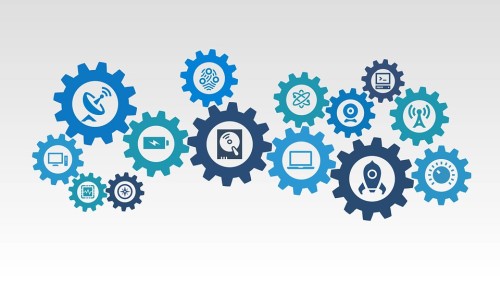Project Description
Businesses currently operate in an information age in which piles of data grow larger by the minute. 90 percent of the world’s data has been created over the last two years alone, and content publishers, users, firms, sensors, and an increasing number of other sources combine to create 2.5 quintillion bytes of data daily. That magnitude of data equates to 90 years of HD video! In order to take advantage of these circumstances, workers must navigate the data landscape by capturing useful pieces of information and effectively utilizing them within their company. After sourcing new information for the firm, the maximization of internal data distribution can help make the most of it. Let’s dive into a few tips on how to achieve an effective dissemination of information.
Communicating in a Network
 Cultivating the belief that every employee is responsible for sending and receiving certain information is a simple but important first step in making sure your company successfully distributes its internal information.
Cultivating the belief that every employee is responsible for sending and receiving certain information is a simple but important first step in making sure your company successfully distributes its internal information.
Thus, it’s useful to view each person as a node in the network through which data flows. How can you create alignment between the different nodal connections? Effective communication helps to achieve this.
To successfully transmit information, employees should first listen before shooting information around, balancing the speed of transfer with the situational relevance. Doing so increases the chances of a given piece of information flowing to where it’s useful, when it’s useful.
“The key always is who’s got the best information to make the best possible decision at that discrete moment in time when that decision can make a difference for your enterprise,”according to Mark Hurd, CEO of Oracle. Great internal information distribution, through solid employee exchange mechanisms, helps to ensure the right person has the right data at the right time.
To motivate communication, it helps to express its importance to employees, both in terms of its value to the SMB and to them as individuals. Opening channels of communication allows employees to share insights, sources, and materials that can impact the organization, empowering those who take advantage of it. It’s also worth mentioning that effectively listening and sending info along to those who find it useful increases an employee’s capability and usefulness, which increases their value. Good things happen to valuable employees.
Utilizing Corporate Messengers
Providing certain tools to employees can also lower communication barriers and play an important part in maximizing the distribution of information. Setting employees up with business-focused messaging apps helps to increase rapidity of intra-organizational exchanges by offering a simple way to transmit information to one another.
It is not desirable to overpopulate the email inbox with tons of daily correspondence between various group and individual threads because information may become disorganized or get lost. Messengers such as Google Hangouts, Slack, Facebook Workplace, and others can lower the burden of email overload by handling the quicker and less formal daily chats regarding sources found, ideas to share, or question and answers. Most, if not all, of these services have versions for both PCs and mobile devices, allowing workers to send and receive information at their desk or on the go, creating an easy and quick avenue for active dialogue between employees.
These corporate messengers provide some additional benefits as well. They help to separate other types of correspondence, like email and personal messages, which is useful for holding distractions in check and organizing categories of information. These services also often auto-populate recipient fields with co-worker information, which is helpful for newcomers on the job who might not yet know or remember the contact info of others. Since they include features for voice and video calling, these messengers also reduce, or even eliminate, the need for company phones.
Note-Taking Mediums

In addition to maintaining solid communication mindsets and techniques, your organization will benefit from recording information in note form. Maintaining a running a log of ideas, questions, concerns, sources, or potential realizations in Apple Notes or Google Docs is never a bad idea. These services let you create folder directories to organize different thoughts. They also provide search features that seek individual words or phrases across all directories and notes in case you need to quickly find a piece of information.
A key benefit to digital note-taking is the ability to share the workspace with others and collaborate in real time. Take note that, compared to Google Docs and Word, Apple Notes demonstrates lackluster performance in this department, because it doesn’t yet let you see who added what information and when. The only way to identify contributions involves manually selecting different fonts or colors in order to differentiate users, and the ability to do that is only a feature on the desktop version of Apple Notes. The app also doesn’t offer annotation features, which are helpful for including metacognition while forming ideas. For these reasons, shared Google Docs or Word documents generally provide a better workspace for collaborative note-taking and brainstorming. With the ability to annotate specific sections, track authorship, and share access, these spaces effectively serve as canvasses for organizing information.
ERP Software
To further facilitate information distribution beyond collaborative note-taking applications, your SMB might consider utilizing enterprise resource planning software. Such programs visualize workflows to help keep everyone on the same page. They also serve as central data repositories to store information from which your company can derive insights to make better decisions. Finding the correct enterprise resource planning service for your company often requires an assessment of individual pain points and needs. There are online resources available to help you navigate this decision.
Bringing it All Together
Divvying up communication and data transfer between messengers, notes, and planning software helps to open up email, phone calls, and in-person discussions for other essential information exchanges. This separation helps to coordinate the large flow of correspondence firms typically deal with nowadays. Such stratification can also provide clues to recipients as to what type of information was sent. This may save time when operating on a strict timeline with a need to quickly classify and filter incoming information based on priority.
It is desirable and lucrative to provide employees with the ability to effectively transmit info through the appropriate medium for the information at hand. Fulfilling this desire helps maximize the distribution of information in an organization, which increases the value of the new info it takes in. A given amount of intake will go farther with better distribution.



